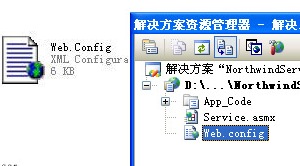
The Web.config file is an XML text file, which is used to store the configuration information of the ASP.NET Web application (such as the most commonly used authentication method for setting the ASP.NET Web application). It can appear in the application. in each directory. When you create a new Web application through VB.NET, a default Web.config file will be automatically created in the root directory by default, including default configuration settings, and all subdirectories will inherit its configuration settings. If you want to modify the configuration settings of a subdirectory, you can create a new Web.config file in the subdirectory. It can provide configuration information in addition to the configuration information inherited from the parent directory, and can also override or modify settings defined in the parent directory.

Modifications to the Web.config file during runtime can take effect without restarting the service (Note: Exception in the
1. web.config configuration file (default configuration settings)
All the following codes should be located in
and
, for learning purposes the following The examples omit this XML tag
1,
Function: configure ASP.NET authentication support (for Windows, Forms, PassPort, None). This element can only be declared at the computer, site, or application level. The
Example:
The following example is a forms-based authentication configuration site. When a user who is not logged in accesses a webpage that requires authentication, the webpage automatically jumps to the login webpage.
<authentication mode="Forms" > <forms loginUrl="logon.aspx" name=".FormsAuthCookie"/> </authentication>
The element loginUrl represents the name of the login web page, and name represents the cookie name
2.
Function: Control client access to URL resources ( such as allowing anonymous user access). This element can be declared at any level (computer, site, application, subdirectory, or page). Required in conjunction with the
Example: The following example prohibits access by anonymous users
<authorization> <deny users="?"/> </authorization>
Note: You can use user.identity.name to get the current authenticated user name; you can use web.Security.FormsAuthentication The .RedirectFromLoginPage method redirects the authenticated user to the page the user just requested.
3.
Function: Configure all compilation settings used by ASP.NET. The default debug attribute is "True". It should be set to True after the program is compiled and delivered for use (details are described in the Web.config file, examples are omitted here)
4,
Role: Provide information about custom error messages for ASP.NET applications. It does not apply to errors that occur in XML Web services.
Example: When an error occurs, jump the web page to a customized error page.
<customErrors defaultRedirect="ErrorPage.aspx" mode="RemoteOnly"> </customErrors>
The element defaultRedirect represents the name of the customized error web page. The mode element means: display custom (friendly) information to users who are not running on the local web server.
5.
Function: Configure ASP.NET HTTP runtime settings. This section can be declared at the computer, site, application, and subdirectory levels.
Example: Control the maximum size of files uploaded by users to 4M, the maximum time to 60 seconds, and the maximum number of requests to 100
<httpRuntime maxRequestLength="4096" executi appRequestQueueLimit="100"/>
6,
Function: identification Page-specific configuration settings (such as whether to enable session state, view state, whether to detect user input, etc.).
Example: Do not detect whether there is potentially dangerous data in the content entered by the user in the browser (Note: This item defaults to detection. If you use non-detection, you must encode or verify the user's input. ), the encrypted view state will be checked when the page is posted back from the client to verify that the view state has not been tampered with on the client side. (Note: This item is not verified by default)
<pages buffer="true" enableViewStateMac="true" validateRequest="false"/>
7.
Function: Configure session state settings for the current application (such as setting whether to enable session state, and save session state Location).
Example:
<sessionState mode="InProc" cookieless="true" timeout="20"/> </sessionState>
Note:
mode="InProc" means: store session state locally (you can also choose to store it in a remote server or SAL server or not Enable session state)
cookieless="true" means: if the user's browser does not support cookies, enable session state (default is False)
timeout="20" means: the session can be idle Status minutes
8,
Function: Configure ASP.NET tracing service, mainly used for program testing to determine where errors occur.
Example: The following is the default configuration in Web.config:
<trace enabled="false" requestLimit="10" pageOutput="false" traceMode="SortByTime" localOnly="true" />
Note:
enabled="false"表示不启用跟踪;requestLimit="10"表示指定在服务器上存储的跟踪请求的数目
pageOutput="false"表示只能通过跟踪实用工具访问跟踪输出;
traceMode="SortByTime"表示以处理跟踪的顺序来显示跟踪信息
localOnly="true" 表示跟踪查看器 (trace.axd) 只用于宿主 Web 服务器
二、自定义Web.config文件配置节
自定义Web.config文件配置节过程分为两步。
一是在在配置文件顶部
二是在
示例:创建一个节存储数据库连接字符串
<configuration> <configSections> <section name="appSettings" type="System.Configuration.NameValueFileSectionHandler, System, Version=1.0.3300.0, Culture=neutral, PublicKeyToken=b77a5c561934e089"/> </configSections> <appSettings> <add key="scon" value="server=a;database=northwind;uid=sa;pwd=123"/> </appSettings> <system.web> ...... </system.web> </configuration>
三、访问Web.config文件
你可以通过使用ConfigurationSettings.AppSettings 静态字符串集合来访问 Web.config 文件示例:获取上面例子中建立的连接字符串。
四、创建Web.config文件
1.在“解决方案资源管理器”中,单击“刷新”图标以确认应用程序还没有 Web.config 文件。
如果已使用网站管理工具或某些其他方式来配置应用程序,则可能已自动创建了 Web.config 文件。单击“刷新”更新文件列表。
2.在“解决方案资源管理器”中,右击网站名称,然后单击“添加新项”。
3.在“模板”窗口中,单击“Web 配置文件”。
“名称”文本框中的文件名应为Web.config。可以为该文件提供其他名称,不过这是默认名称。.config 文件扩展名可防止 ASP.NET 下载相应文件。
4.单击“添加”创建该文件,然后将其打开进行编辑。
该文件包含本主题后面“示例”部分中显示的代码,并具有一些初始默认值。应用程序从 %SystemRoot%\Microsoft.NET\Framework\\CONFIG 目录下的 Machine.config 和 Web.config 文件继承所有配置设置,但在此处看不到这些默认设置。如果要重写继承的默认设置或添加 httpHandlers 元素(ASP.NET 设置架构) 等集合元素,则只需创建应用程序级别和目录级别的 Web.config 文件。
若要查看当前应用程序的所有配置设置,可以运行主题如何:以编程方式查看继承的配置设置和本地配置设置中包含的代码。也可以查看 %SystemRoot%\Microsoft.NET\Framework\\CONFIG 目录下的Machine.config.comments 或 Web.config.comments 文件(这两个文件也包含有用的注释),但这两个文件将不会包含所有运行时设置,请参见如何:以编程方式查看继承的配置设置和本地配置设置。
5.如果更改了 Web.config 文件,则保存该文件。
保存 Web.config 文件会重新启动应用程序。也可以选择使用单个节元素的 configSource 属性指向某个辅助配置文件,更改辅助配置文件不会导致应用程序重新启动。有关更多信息,请参见节元素所继承的常规属性中的 configSource。
Web.config是asp.net应用程序中一个很重要的配置文件,通过Web.config文件可以方便我们进行开发和部署asp.net应用程序。
通过本文的介绍,希望对你有帮助,对ASP.NET配置文件Web.config有更深入的了解。
更多Detailed explanation of ASP.NET configuration file Web.config相关文章请关注PHP中文网!




